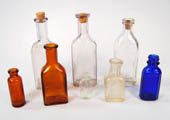
Purpose
To demonstrate how different pitched sounds are made.
Additional information
Pitch is one of the three primary auditory attributes of sound, along with loudness and timbre. It represents the perceived natural frequency (also called fundamental frequency) of sound and can be perceived differently by different people. It's also affected by the amplitude of the sound, especially at lower frequencies where a low note will sound lower in pitch when it's played at a louder level.
Sponsored Links
Required materials
- 5 to 8 identical glass bottles. These could be thin jars, beakers, or even empty glass soda bottles.
- Water
- A spoon, fork, or butter knife
Estimated Experiment Time
Less than 5 minutes to set-up, as much time as you want to make music!
Step-By-Step Procedure
- 1. Place the bottles in a straight line, about 2 to 4 inches apart from each other.
- 2. Fill the bottles one-by-one until the water level is staggered. For example, fill the first bottle with a small amount of water. Fill the second bottle with more water than the first bottle. Fill the third bottle with more water than the second bottle, and so forth and so on until all of your bottles have a varying amount of water. when your done the first bottle should have the least amount of water and the last bottle the most.
- 3. Take your spoon, fork, or knife, and strike the tops of each bottle one after the other and listen to the different pitches.
- 4. Strike the bottles in any order to make music.
Note
The pitch created is dependant not only on the amount of water, but the size and type of bottle being used. It's important to use the same types of bottle for the best musical result.
If you want to make a musical scale, place the bottles in order from the one that makes the lowest sound to the one that makes the highest sound (you may need to remove or add water to some of the bottles).
Observation
Can you play a tune on your musical bottles, such as "Mary Had a Little Lamb?". Hit the bottles with your fork and listen to the pitch from each one. Try to associate it to the notes of "Mary Had a Little Lamb" to the pitch of the bottles. You can even label your bottles from 1 to 5 or 1 to 8 (depending on the number of bottles you used) and use tape to mark the water levels. This way you can your notes (the bottle numbers) down on paper and perform the same musical concert each time you conduct the experiment!
Result
The more water in the bottle, the lower the pitch will be when played. This is because the sound vibrations you can hear come from the actual bottle, as you add water it takes on greater vibrating mass. The less water that's in the bottle means there is less weight that vibrates and the pitch is higher.
Sponsored Links
Take a moment to visit our table of Periodic Elements page where you can get an in-depth view of all the elements,
complete with the industry first side-by-side element comparisons!